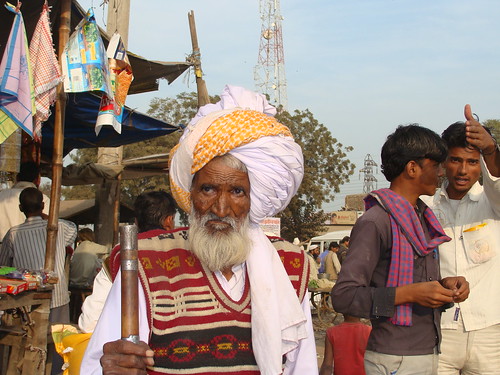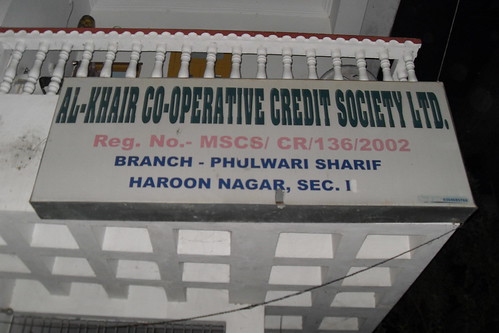By Tameemuddin Humble
The vast majority of the Muslim population in India is chronically poor and destitute and cannot avail the welfare schemes of the government meant for them through the formal financial institutions.
Muslim access to banking services
The financial exclusion of the community is further proved with the recent reports that 50,000 Muslim students in Bihar and 90,000 in Andhra Pradesh could not open the bank accounts to deposit their scholarship cheques. The complaints were received by the State Minorities Commission which, in turn, referred them to the National Commission for Minorities in Delhi. The Ministry of Minority Affairs (MMA) took up the matter and wrote to all States’ Chief Secretaries directing them to facilitate the opening of “no frills, nil balance” accounts by minority students. Though there is a long standing RBI circular in this direction.

A Mewati Muslim [TCN Photo]
In the case of loan, the Sachar committee’s finding is that Muslims did not easily get loans. The committee further says that the Muslim community’s share of outstanding PSAs was pathetic — only 4.6 per cent as against a population share of 13.4 per cent. In 44 districts, where the Muslim share of the population was 33 per cent, their share of PSAs was an abysmal 7.9 per cent. The share of other minorities, who together constituted two per cent of the population, was 3.7 per cent. In 11 of these districts, where the Muslim share of the population was 51.4 per cent, their share of PSAs was 12.9 per cent. With a 1.2 per cent share of the population in the same districts, other minorities received 3. 4 per cent of PSAs while Hindus, who formed 47.4 per cent of the population, got a PSA share of 63.1 per cent. Over all, other minorities fared twice as well as Muslims in the priority sector. Banks confirmed the existence of “red zones” where they offered minimal services. Unfortunately, most of the areas where Muslims live fall in the red zones.”
But the financial problem of the community would not be solved even by the spread of the commercial banks with proper services in Muslim concentration areas as we all know the commercial banks are based on the minimization of risks and maximization of profits and unfortunately cannot reach the masses.
Almost 75% of Muslims in the country don’t get benefit from the formal financial services extended by the government due to unable in providing the required collaterals against the borrowings and finding no guarantor standing for them. This problem is furthered because of the ruling of the Supreme Court that “the principal debtor and the guarantor are equally liable to be proceeded at the same time against for recovery of a loan by the creditor.” The legal position is clear that “liability of the guarantor and principal debtor are co-extensive and not in alternative’’ said a Bench of justices Dalveer Bhandari and H L Dattu.
Reserve Bank of India Governor D. Subbarao urged bankers to meet the four formidable challenges before them: deepening financial inclusion, financing infrastructure, strengthening risk management and improving efficiency “Commercial banking in India has not penetrated sufficiently to serve the large mass of rural, illiterate and poor people in any meaningful way,” the RBI Governor noted. The intermediation cost in India is still high, largely due to high operating costs, said Dr. Subbarao. The challenge for the Indian banks is to reduce the costs and pass on the benefits to both depositors and lenders.
Microfinance—the way to inclusive finance
Thus the big challenge India is facing now is the financial inclusion of a large segment of the population. And this challenge could only be met through the proper application of microfinance.
In the Budget 2010 the UPA Government has set a deadline, i.e., March 2012 to carry out the financial inclusion drive that has the target to cover 60,000 habitations through the Lead Bank Scheme to reach the unbanked people. The scheme is to provide appropriate banking facilities to habitations with more than 2,000 populations.
Now the average population coverage by a commercial bank branch in urban areas is 9,400 and in rural and semi urban areas it is 15,900 as on June 30, 2010.
Micro-finance movement in India can be traced back in 1992 when NABARD linked SHG with banks. The working definition of micro-finance is given by NABARD in 1998 which states: “Provision of thrift (saving), credit, and other financial services and products of very small amount to the poor in rural, semi-urban and urban areas for enabling them to raise their income levels and improve living standards.” It is a paradigm shift from class banking to mass banking growing at the rate of 60% and covers the population earning more than $2 a day. Out of 9 crore clients or customers of MFIs in India, 80% are women and 90% have Sc/ST and minority background.
The main point of departure of microfinance from mainstream finance is its alternative approach to collateral and thus becomes the powerful tool to achieve 100% financial inclusion.
Islamic (Interest-free) Microfinance
Micro-finance provides financial services to poor and low income people whose low income standing excludes them from formal banking systems. Now-a-days financial credit is treated as a human right. They need financial services to meet their life-cycle events such as birth, marriage, old age and in emergencies. In India 40% of Muslim population is unbankable.
Actually Islamic microfinance is a confluence of Microfinance and Islamic banking.
Microfinance was earlier a social experiment but unfortunately it has now becoming a profit making sector for today’s money lenders.
It is all in the name of empowering the poor. One can ask the practitioners of microfinance, who charges 24% rate of interest, how you justify the exorbitant rate of interest. At 24 per cent rate of interest the micro-finance institutions (MFIs) are empowering the poorest of the poor where as the rate of interest for the urbanites, whether it is for housing, for car, or for any other business activity, as low as 6 to 8 per cent.
If the poor can be empowered with a 24 per cent rate of interest, how the resourceful persons need a much lower interest rate to get empowered? If the poor in the villages can make a business enterprise even after paying a 20-24 per cent rate of interest, why do people in the cities find it difficult to do so? Or is it that we need a different yardstick to empower the poor and the not-so-poor? In other words, since the poor have no voice, the MF practitioners have joined hands to exploit the poor in the name of poverty alleviation.
Isn’t it shocking that a poorest of the poor in a village, who may be only surviving on the NREGA promise of 100 days assured employment has to pay a 24 per cent rate of interest if he borrows money to buy a goat, and we in the cities can get interest-free loans or loans with a minimum rate of interest for buying a car.
Another report tells us that SKS Micro-finance is charging approximately 24 per cent rate of interest in Orissa, Karnataka and Andhra Pradesh; in southern India, Equitas Micro-finance is seeking 21-28 per cent interest rate and Basix Microfinance is providing small loans at 18-24 per cent interest rate. There are numerous other players, and they all rake in money. Sewa in Gujarat and the Grameen Bank in Bangladesh too thrive on a similarly high rate of interest.
It is the time we put all of them under a scanner. The society cannot turn a blind eye to this organised financial loot
We see the MFIs use the bank finance (or donors money) and then they charge a little less at 20-24%.
In the process the MFIs literally make a killing from robbing the poorest of the poor.
If that MFIs be made interest free to lesser the burden on borrowers and thus besides following Islamic system we expect not only the rate of growth could increase but also the poverty would be alleviated smoothly.
Micro-finance and Islamic-finance have some common features such as both works around well being of a society as a whole and share risk and believe that the poor should take part in developmental process. But the difference lies here when conventional microfinance providers charge average 24% annual rate of interest that are benchmarked against mainstream banking rates whereas Islamic finance is based on the Equity Finance. The need of Islamic Finance is not only in India but all over the world because the 72% Muslims of the world don’t use formal financial services—credit, insurance, savings etc. due to interest or Riba in the system.

Al-Khair Co-operative Credit Society Ltd., a multi-state level MFI headquartered in Patna and functioning in Bihar & U. P. is working in the field of microfinance for the last 8 years charges only Rs.35 for the loan of Rs. 1000. Its service charge do goes up but not more than 5 to 7% for higher amount. The institution is running its four branches successfully on co-operative format of microfinance. Al-Khair levies service charge once even if time period of borrowing goes beyond one year or whatever. The Islamic Micro-Finance could provide greater stability than conventional Microfinance.
Economic deprivation is one of the big problems of Muslims in India and the community leaders have to search out the way to alleviate it. The charity based (Zakah & Sadaqa) solution to the challenge of poverty could not be sustainable because of its fluctuations and thus could not be the part of the careful planning and implementation, besides it is meant for the extremely poor. If Waqf properties were managed properly the benefits from it would have been sustainable for the community that is why Sachar Committee Report (SCR) recommends the establishment of Waqf Development Corporation for the purpose. Whereas SCR also finds that most of the entrepreneurs among the community belong to the sector of micro enterprise and here the Islamic Micro-finance could play the important role of a facilitator particularly for the group of artisans mostly found in the Muslim community.
Over the past several years, Govt. of India and Reserve Bank of India have set up many institutions such as Small Industries Development Bank of India (SIDBI), Credit Guarantee Fund Trust, etc. to promote collateral free and third party guarantee free credit flow to micro enterprises. It has also to facilitate the MFIs in promoting the micro credit culture in the country. The Islamic Microfinance Institutions of the country could avail these opportunities in alleviating poverty from the community.
Thus we see the community itself can draw a strategy of economic empowerment availing the benefits of given opportunities for them. Poverty eradication in Islam is a cherished goal and the Islamic micro-finance is the best way for Muslim organizations to practice considering the economic condition of the community in India.
Islamic Microfinance Institutes (IMI) should be established in every economically weak Muslim locality so that they could easily get financial services to meet their basic needs and develop a habit of saving which is quite absent from the culture of wage earners.
The Islamic Microfinance for poverty alleviation is more inclusive than conventional Microfinance because it minimizes the dependency on charity and facilitates the benefits to flow to the poorest of poor and the destitute, which are not in a position to generate any income and wealth from the present day interest-ridden formal financial institutions.
— Tameemuddin Humble is the Secretary of Muslim Empowerment Forum in Gaya, Bihar. He can be reached at [email protected]

